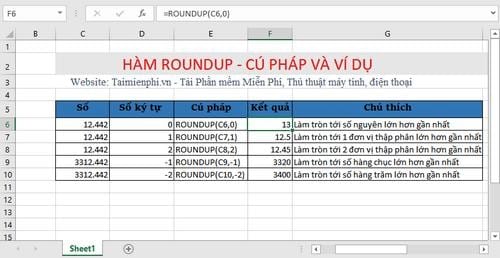How to round numbers using the Roundup function in Excel
The Roundup function in Excel rounds a decimal number to the nearest integer or to a certain number of digits. Learn the syntax and how to use it to work with numeric data faster.
What is the Roundup function?
The Roundup function in Excel rounds numbers up according to the rule: numbers after the decimal point greater than 0 will always be rounded up, instead of rounding according to the usual rule.
Usage syntax
Syntax: =ROUNDUP(A, B)
- A: the number sequence or symbol of the cell containing the number sequence you need to round up
- B: the number of decimal places you want to round up.
Example: Round a number up to the nearest integer
We have the number 12,442 in cell C6, to round up this number to the nearest positive integer we have the syntax =ROUNDUP(C6,0) or =ROUNDUP(12,442,0) with 0 here being 0 decimal places (no decimal places) we get the number 13. Because 13 is greater than 12,442 and is the nearest positive integer.

Free Download has guided you how to use the ROUNDUP function in Excel to round numbers up, helping to calculate quickly when processing data. Through the above example, you can clearly understand how this function works.
To work more effectively with Excel, you should master basic calculation functions such as rounding function , counting function. These functions often appear and provide effective support in your work, helping you to manipulate spreadsheets more easily.
You should read it
- ROUND, ROUNDDOWN, ROUNDUP functions - Functions for rounding decimal numbers in Excel
- How to round numbers in Excel using the ROUND, ROUNDUP, ROUNDDOWN Function
- Roundup of new Chrome features and security updates
- How to use the rounding function in Excel simply and effectively
- 5 ways to create unique Spotify playlists
- 10 ways to get extremely effective backlinks you may not know yet
- A look at Google's 2018: A year of volatility
- The process of turning 200kg whale hearts into 'plastic hearts' is not decomposed
May be interested
- How to use the rounding function in Excel simply and effectively
 when working with excel, you will need to round numbers to suit your calculations and reports. excel provides many rounding functions such as round(), roundup(), rounddown(), which help control rounding according to specific needs.
when working with excel, you will need to round numbers to suit your calculations and reports. excel provides many rounding functions such as round(), roundup(), rounddown(), which help control rounding according to specific needs. - How to remove all Hyperlinks in Word fastest
 hyperlinks help navigate quickly in text but sometimes they are unnecessary. if you want to quickly remove all hyperlinks in word, apply the following methods to handle it quickly without affecting the original content.
hyperlinks help navigate quickly in text but sometimes they are unnecessary. if you want to quickly remove all hyperlinks in word, apply the following methods to handle it quickly without affecting the original content. - The simplest way to insert images into the Comment box in Excel
 inserting images into the comment box in excel helps display images as soon as you hover over the cell containing data, making it convenient for managing records. this article will guide you through the steps in simple steps, applicable to popular versions of excel.
inserting images into the comment box in excel helps display images as soon as you hover over the cell containing data, making it convenient for managing records. this article will guide you through the steps in simple steps, applicable to popular versions of excel. - How to insert Text Box in Word simply, anyone can do it
 text box in word helps you create a prominent text frame, increasing the aesthetics of the text. with just a few simple steps, you can insert and customize the text box as you like. let's find out how to do it right after.
text box in word helps you create a prominent text frame, increasing the aesthetics of the text. with just a few simple steps, you can insert and customize the text box as you like. let's find out how to do it right after. - Instructions for connecting and merging multiple Excel files into 1 file easily
 merge multiple excel files into one file to manage data conveniently and save time. you can use vba or the move/copy feature to do it. below are detailed step-by-step instructions.
merge multiple excel files into one file to manage data conveniently and save time. you can use vba or the move/copy feature to do it. below are detailed step-by-step instructions. - How to copy formulas and data between Excel tables quickly
 copying formulas and data between excel tables helps you work more efficiently without having to re-enter them manually. depending on your needs, you can use keyboard shortcuts or advanced features to ensure accurate copying. let's explore effective ways to do it in this article.
copying formulas and data between excel tables helps you work more efficiently without having to re-enter them manually. depending on your needs, you can use keyboard shortcuts or advanced features to ensure accurate copying. let's explore effective ways to do it in this article.






 ROUNDUP function in Excel - Usage and examples
ROUNDUP function in Excel - Usage and examples How to round numbers in Excel using the ROUND, ROUNDUP, ROUNDDOWN Function
How to round numbers in Excel using the ROUND, ROUNDUP, ROUNDDOWN Function PI (PI Function) in Excel - How to use PI numbers in Excel
PI (PI Function) in Excel - How to use PI numbers in Excel How to use the rounding function in Excel simply and effectively
How to use the rounding function in Excel simply and effectively Compare ROUND, ROUNDUP and ROUNDDOWN rounding functions in Excel
Compare ROUND, ROUNDUP and ROUNDDOWN rounding functions in Excel